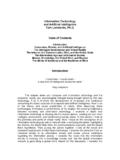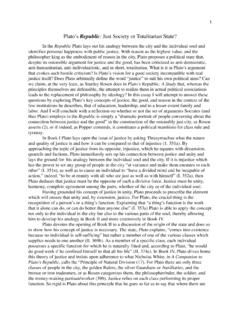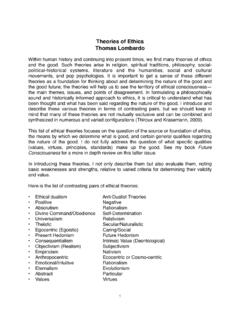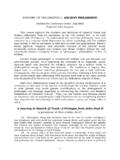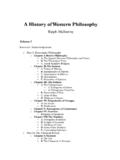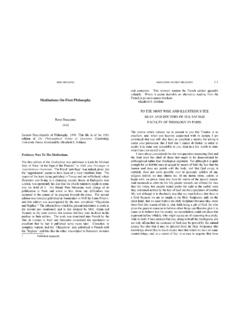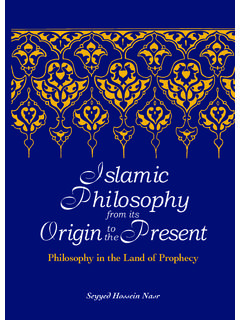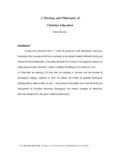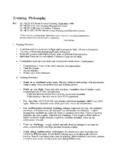Transcription of Ancient Myth, Religion, and Philosophy
1 1 Ancient Myth, religion , and Philosophy "Progress, far from consisting in change, depends on when experience is not retained, as among savages, infancy is perpetual. Those who cannot remember the past are condemned to repeat this is the condition of children and barbarians, in whom instinct has learned nothing from experience." George Santayana Thinking about the future has a rich and deep There is much to be learned from past ideas and images of the future. In fact, contemporary views of the future, in many significant ways, are inspired and derived from earlier ideas and theories.
2 Understanding our present views of the future requires looking at how different ideas and approaches to it have developed through the ages. The past puts the present into perspective; the present has been built upon the past. In biological evolution, many of the features of earlier life forms are carried over into later forms. Evolution in biology is to a great degree cumulative. The same is true for the history of future consciousness and, for that matter, the entire history of the human mind ideas, insights, and discoveries build upon themselves. To borrow a metaphor from Isaac Newton, the futurists of the present can see outward as well as they can because they stand on the shoulders of giants.
3 In this chapter, I examine the earliest recorded ideas, in printed word, on the future. These ideas build upon the prehistoric foundations described in the previous chapter and add new themes and concepts that have contributed to the ongoing evolution of future consciousness. Although prehistoric mythograms and other artistic representations may contain prophecies of the future, there is presently no accurate or reliable way to decipher the detailed meanings of these Ancient images. According to Fraser, there is no clear evidence in prehistoric art that early humans thought in global or universal terms about either the past or the Christian states that, as best as can be ascertained, prehistoric humans appeared to have thought in relatively concrete terms about local and specific Questions about the origin or destiny of the universe, or even of humankind, do not seem to have occurred to them.
4 Still, it was the basic themes and concerns of prehistoric life of reproduction and death, of hunting and the kill that led to the development of future consciousness and the first recorded views of the future. The earliest written ideas about the future dating back around five thousand years are mythological and contain both descriptions of the past and prophecies of the future, including explanations of the origin and purpose of humanity and the cosmos. Within these Ancient myths past and future are causally and thematically connected the future flows out of the past.
5 These Ancient mythic views of the origin, history, and future of humanity and the cosmos invariably contain references to deities, gods, and goddesses. The past 2 and future in Ancient myth are personified. These deities are variously seen as supernatural - above or separate from nature - or as part of nature, actively involved in directing physical events and human history they are both transcendent and immanent. Often these deities are responsible for the creation of the universe and humankind and often they significantly influence or determine the future and the ultimate purpose of the cosmos.
6 The future is often seen as controlled by destiny, fate, and the will of the gods. Mythic views are usually expressed in narrative form, involving personalities and personal challenges, interpersonal conflicts, adventure, and drama. The life of the universe and the saga of humankind are conceptualized as stories. Ancient myths with their gods and goddesses would provide one primary source of inspiration for the development of traditional religions around the world. Socially organized religions incorporated into their belief systems earlier mythic stories and prophecies, as well as rituals and moral systems of behavior that provided direction for how to live.
7 Myth would also impact the development of Ancient philosophical views regarding reality, time, morals, and the future. In this chapter I cover the history of myth and religion from around 3000 BC (or BCE Before the Common Era) to the rise and flourishing of Christianity and Islam around 1000 AD. I examine both Eastern and Western religion and myth, including Egyptian, Mesopotamian/Babylonian, Zoroastrian, Hindu, Buddhist, Taoist, Greco-Roman, Judaic, Christian, and Islamic ideas on the past and future. As a prelude to the next chapter, where I describe the rise of rational-scientific approaches to the future in modern times, I also describe in this chapter the beginnings of Western Philosophy in Ancient Greece (600 to 300 BC).
8 Although Greek Philosophy , in so far as it approached reality from a rational and abstract point of view, was in many ways at odds with religious-mythic thinking, Greek Philosophy did influence the development of Christianity in the first Millennium and any complete explanation of the Christian vision of the future needs to discuss the influence of Greek thinking. The Power of Mythic Narrative .. myths are archetypal patterns in human consciousness and where there is consciousness there will be myth.. In the moments when eternity breaks into time, there we will find myth.
9 Rollo May myths provided the first systematic explanations of history and the first prophecies of the future. For most of recorded history, the primary mode of understanding both the past and the future has been the myth stories and sagas describing the challenges, meaning, and purpose of life. The first meaning listed for the term myth in The Oxford American College Dictionary is a traditional story. The term myth can also mean a superstitious or fanciful tale without factual support. Although early myths do 3 indeed contain references to spirits, fantastical creatures, and supernatural beings, and describe cosmic or earthly events that are scientifically implausible, Ancient myths were invariably grounded in important facts about nature and the meaning and psychology of human life.
10 The fact that our earliest written explanations of the past and future were mythic in form can be placed in an evolutionary context. According to Merlin Donald, in his Origins of the Modern Mind, the third fundamental stage in the cognitive evolution of hominids, after the episodic and the mimetic, was the mythic, which was associated with the emergence of modern Homo sapiens. (For Donald, Homo erectus behaved and thought in a mimetic fashion, an advance over Australopithecus, who functioned at an episodic level.) Probably coincident with the emergence of cave art and mythograms, humans began to develop organized explanations of nature and human reality in the form of narrative myths .

